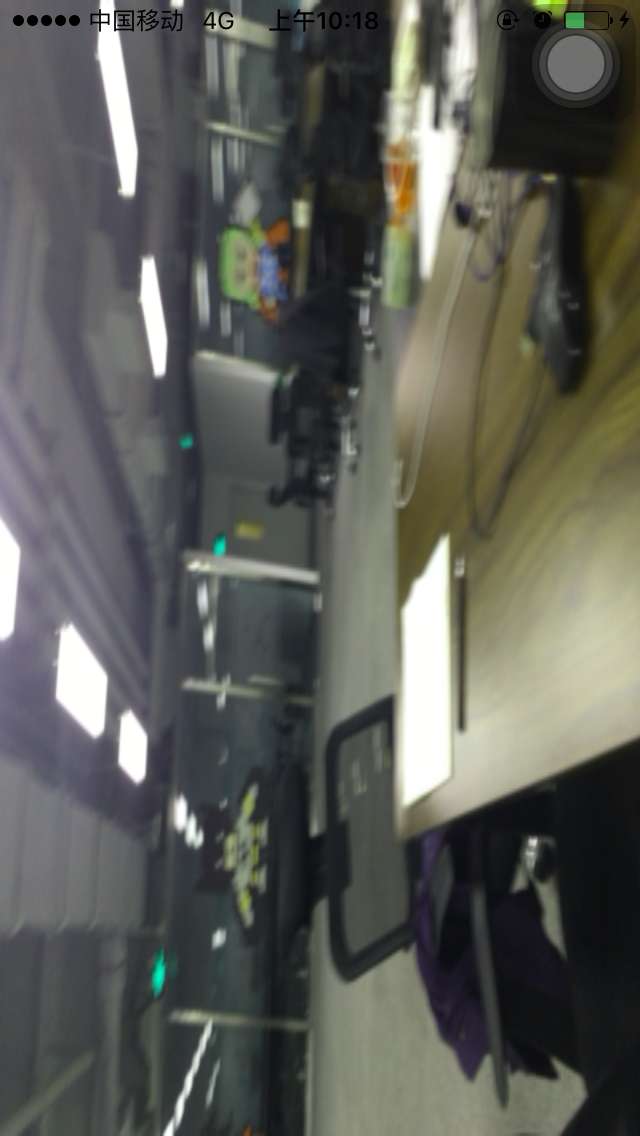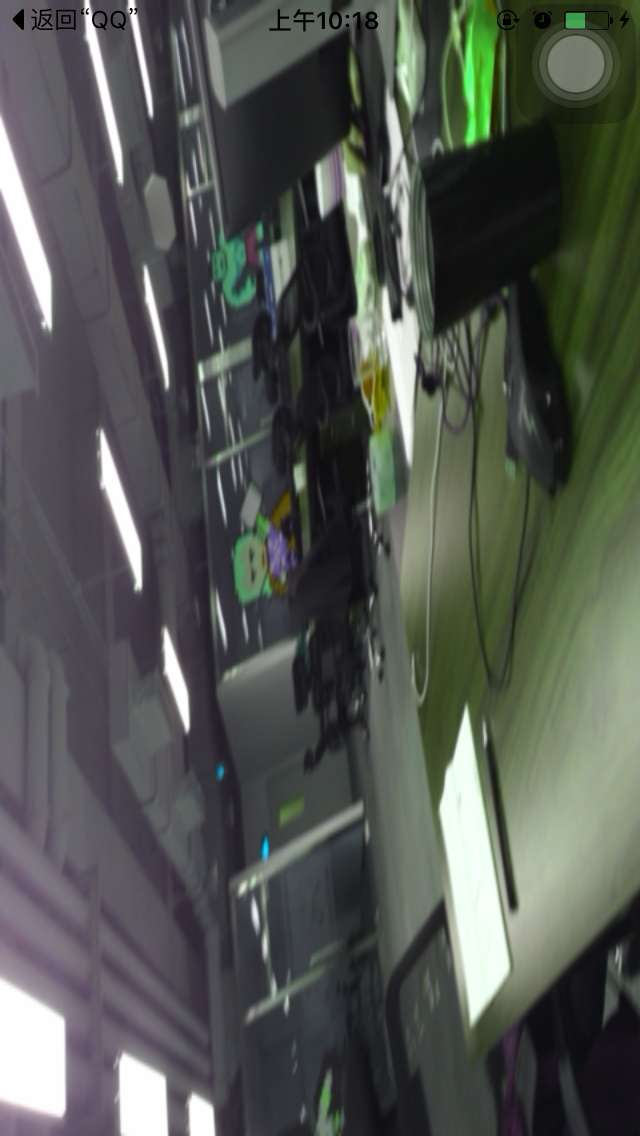視訊流的處理(實時美顏、濾鏡)並通過簡單的coreImage渲染
阿新 • • 發佈:2019-02-19
主要思路 :通過攝像頭捕獲畫面,獲取視訊流之後,進行美顏處理,然後將處理後的流給coreImage進行渲染
視訊的捕獲:框架 AVFoundation/AVFoundation.h
說明:
AVCaptureDevice 是關於相機硬體的介面。它被用於控制硬體特性,諸如鏡頭的位置、曝光、閃光燈等。
AVCaptureOutput 是一個抽象類,描述 capture session 的結果。以下是三種關於靜態圖片捕捉的具體子類:
AVCaptureStillImageOutput 用於捕捉靜態圖片
AVCaptureMetadataOutput 啟用檢測人臉和二維碼
AVCaptureVideoOutput 為實時預覽圖提供原始幀
AVCaptureSession 管理輸入與輸出之間的資料流,以及在出現問題時生成執行時錯誤。
說明:
AVCaptureVideoPreviewLayer 是 CALayer 的子類,可被用於自動顯示相機產生的實時影象。它還有幾個工具性質的方法,可將 layer 上的座標轉化到裝置上。它看起來像輸出,但其實不是。另外,它擁有 session (outputs 被 session 所擁有)。 AVCaptureSession用來控制輸入裝置(AVCaptureDeviceInput)視訊影象到流入輸出緩衝區(AVCaptureOutput)的過程。一旦AVCaptureSession啟動以後,就會收集來自輸入裝置的資訊,並在適當的時候將這些資訊輸出到資料緩衝區中。 AVCaptureVideoPreviewLayer預設情況下會顯示來自輸入裝置的原始資料,如果要實現實時濾鏡或在這個圖層上繪製額外的物體,那麼就要衝視訊輸出緩衝區獲取資料幀資料,並對其進行處理,處理完畢後可將畫素資料輸出到另一個圖層或者OpenGL上下文中。
**
如果僅僅獲取攝像頭資料:
效果如下:
**

程式碼如下:
- (void)viewDidLoad {
[super viewDidLoad];
// Do any additional setup after loading the view, typically from a nib.
[self setupCaptureSession];
}
- (void)setupCaptureSession
{
// 初始化GPUView
_gpuView = [[GPUView alloc] initWithFrame:self.view.bounds];
[self.view addSubview:_gpuView];
self.view.backgroundColor = [UIColor redColor];
NSError *error = nil;
// 初始化第二個CIFilter
// Create 如果對影象進行coreImage進行GPU渲染,需要使用這個代理 AVCaptureVideoDataOutputSampleBufferDelegate- (void)captureOutput:(AVCaptureOutput *)captureOutput didDropSampleBuffer:(CMSampleBufferRef)sampleBuffer fromConnection:(AVCaptureConnection *)connection NS_AVAILABLE(10_7, 6_0);對得到的sampleBuffer 進行處理
效果 如下:
程式碼如下:
#import "ViewController.h"
#import <AVFoundation/AVFoundation.h>
//#import <CoreImage/CoreImage.h>
#import "GPUView.h"
@interface ViewController ()<AVCaptureVideoDataOutputSampleBufferDelegate>
{
AVCaptureVideoPreviewLayer *preLayer;
}
@property (nonatomic, strong) CIFilter *ciFilter2;
@property (nonatomic, strong) GPUView *gpuView;
@end
@implementation ViewController
- (void)viewDidLoad {
[super viewDidLoad];
// Do any additional setup after loading the view, typically from a nib.
[self setupCaptureSession];
}
- (void)setupCaptureSession
{
// 初始化GPUView
_gpuView = [[GPUView alloc] initWithFrame:self.view.bounds];
[self.view addSubview:_gpuView];
self.view.backgroundColor = [UIColor redColor];
NSError *error = nil;
// 初始化第二個CIFilter
// Create the session
AVCaptureSession *session = [[AVCaptureSession alloc] init];
// Configure the session to produce lower resolution video frames, if your
// processing algorithm can cope. We'll specify medium quality for the
// chosen device.
session.sessionPreset = AVCaptureSessionPresetMedium;
// Find a suitable AVCaptureDevice
AVCaptureDevice *device = [AVCaptureDevice
defaultDeviceWithMediaType:AVMediaTypeVideo];
// Create a device input with the device and add it to the session.
AVCaptureDeviceInput *input = [AVCaptureDeviceInput deviceInputWithDevice:device
error:&error];
if (!input) {
// Handling the error appropriately.
}
[session addInput:input];
// Create a VideoDataOutput and add it to the session
AVCaptureVideoDataOutput *output = [[[AVCaptureVideoDataOutput alloc] init] autorelease];
[session addOutput:output];
// Configure your output.
dispatch_queue_t queue = dispatch_queue_create("myQueue", NULL);
[output setSampleBufferDelegate:self queue:queue];
dispatch_release(queue);
// Specify the pixel format
output.videoSettings =
[NSDictionary dictionaryWithObject:
[NSNumber numberWithInt:kCVPixelFormatType_32BGRA]
forKey:(id)kCVPixelBufferPixelFormatTypeKey];
// If you wish to cap the frame rate to a known value, such as 15 fps, set
// minFrameDuration.
output.minFrameDuration = CMTimeMake(1, 15);
// [self setSession:session];
// Start the session running to start the flow of data
// preLayer = [AVCaptureVideoPreviewLayer layerWithSession:session];
// preLayer.videoGravity = AVLayerVideoGravityResizeAspect;
// preLayer.frame = [UIScreen mainScreen].bounds;
// [self.view.layer addSublayer:preLayer];
[session startRunning];
}
// Delegate routine that is called when a sample buffer was written
- (void)captureOutput:(AVCaptureOutput *)captureOutput
didOutputSampleBuffer:(CMSampleBufferRef)sampleBuffer
fromConnection:(AVCaptureConnection *)connection
{
UIImage *image = [self imageFromSampleBuffer:sampleBuffer];
CIImage *ciimage = [[CIImage alloc] initWithImage:image];
_ciFilter2 = [CIFilter filterWithName:@"CIHueAdjust"];
[_ciFilter2 setValue:ciimage forKey:kCIInputImageKey];
[_ciFilter2 setValue:@1.f forKeyPath:kCIInputAngleKey];
CIImage *outputImage = [_ciFilter2 outputImage];
[_gpuView drawCIImage:outputImage];
}
// Create a UIImage from sample buffer data
- (UIImage *) imageFromSampleBuffer:(CMSampleBufferRef) sampleBuffer
{
// Get a CMSampleBuffer's Core Video image buffer for the media data
CVImageBufferRef imageBuffer = CMSampleBufferGetImageBuffer(sampleBuffer);
// Lock the base address of the pixel buffer
CVPixelBufferLockBaseAddress(imageBuffer, 0);
// Get the number of bytes per row for the pixel buffer
void *baseAddress = CVPixelBufferGetBaseAddress(imageBuffer);
// Get the number of bytes per row for the pixel buffer
size_t bytesPerRow = CVPixelBufferGetBytesPerRow(imageBuffer);
// Get the pixel buffer width and height
size_t width = CVPixelBufferGetWidth(imageBuffer);
size_t height = CVPixelBufferGetHeight(imageBuffer);
// Create a device-dependent RGB color space
CGColorSpaceRef colorSpace = CGColorSpaceCreateDeviceRGB();
// Create a bitmap graphics context with the sample buffer data
CGContextRef context = CGBitmapContextCreate(baseAddress, width, height, 8,
bytesPerRow, colorSpace, kCGBitmapByteOrder32Little | kCGImageAlphaPremultipliedFirst);
// Create a Quartz image from the pixel data in the bitmap graphics context
CGImageRef quartzImage = CGBitmapContextCreateImage(context);
// Unlock the pixel buffer
CVPixelBufferUnlockBaseAddress(imageBuffer,0);
// Free up the context and color space
CGContextRelease(context);
CGColorSpaceRelease(colorSpace);
// Create an image object from the Quartz image
UIImage *image = [UIImage imageWithCGImage:quartzImage];
// Release the Quartz image
CGImageRelease(quartzImage);
return (image);
}@end
gpuimage
//
// GPUView.m
// OpenGL_ES_1
//
// Created by fsk-0-1-n on 16/9/8.
// Copyright © 2016年 Xoxo. All rights reserved.
//
#import "GPUView.h"
@interface GPUView ()
@property (nonatomic, assign) CGRect rectInPixels;
@property (nonatomic, strong) CIContext *context;
@property (nonatomic, strong) GLKView *showView;
@end
@implementation GPUView
- (id)initWithFrame:(CGRect)frame
{
self = [super initWithFrame:frame];
if (self)
{
// 獲取OpenGLES渲染環境
EAGLContext *eaglContext = [[EAGLContext alloc] initWithAPI:kEAGLRenderingAPIOpenGLES2];
// 初始化GLKView並指定OpenGLES渲染環境 + 繫結
_showView = [[GLKView alloc] initWithFrame:frame context:eaglContext];
[_showView bindDrawable];
// 新增進圖層
[self addSubview:_showView];
// 建立CIContext環境
_context = \
[CIContext contextWithEAGLContext:eaglContext
options:@{kCIContextWorkingColorSpace:[NSNull null]}];
// 定義繪製區域(畫素描述)
_rectInPixels = \
CGRectMake(0.0, 0.0, _showView.drawableWidth, _showView.drawableHeight);
}
return self;
}
- (void)drawCIImage:(CIImage *)ciImage
{
// 開始繪製
[_context drawImage:ciImage
inRect:_rectInPixels
fromRect:[ciImage extent]];
//將CIImage轉變為UIImage
// CGImageRef cgimg = [_context createCGImage:ciImage fromRect:[ciImage extent]];
// UIImage *newImg = [UIImage imageWithCGImage:cgimg];
// CGImageRelease(cgimg);
// 顯示
[_showView display];
}
@end


